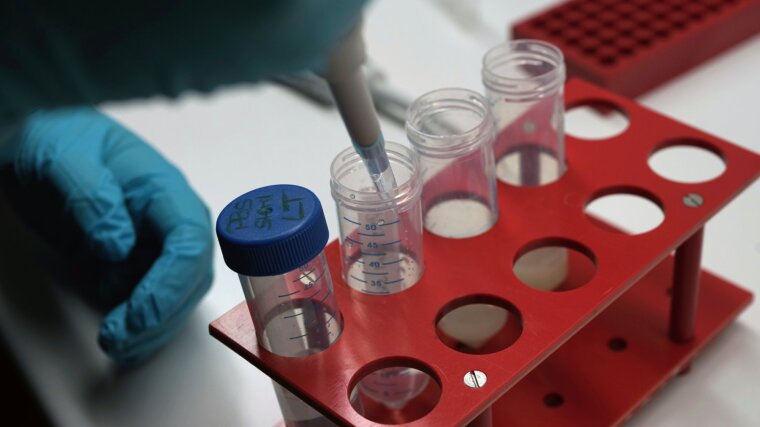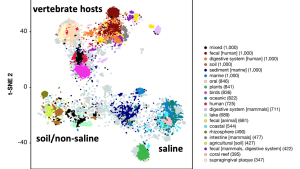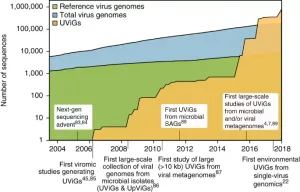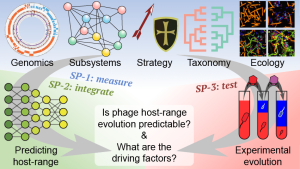
Studying the Microverse
This figure shows the first “Map of the Microverse”, consisting of 22.5 thousand microbial datasets from 140 different types of environments. We identified generalist and specialist bacteria by analysing their distribution across these 22.5 thousand datasets.
Image: Von Meijenfeldt et al., Nature Ecology and Evolution 2023The Microverse is defined as the globally connected network of microbiomes that covers the Earth and all things on it. With its ~1030 microbes and ~1031 viruses, the Microverse is among the most complex systems we know. Similar environments may have different microbial compositions. For example human gut microbiomes can vary significantly even between related individuals on the same diet. To a much greater extent, however, we observe differences at the global scale between the microbes that inhabit different types of environments, such as host-associated, soil, and marine biomes. This is nicely shown in the "Map of the Microverse" figure from our 2023 paperExternal link.
In the VEO Group we study viral and microbial ecology across biomes, ranging from environmental (freshwater, marine, terrestrial) to host-associated (human, insect, plant). In the Microverse Cluster we try to understand "Balance": What is balanced? When do we observe it? How do we measure it? How does balance turn into disbalance? Can we fix it? As it goes with research, we take small steps but try to make them as robust as possible. In doing so, we believe that our Microverse-wide view helps to identify fundamental principles and gives us a deeper understanding of our microbial world.
Viral Ecology
The number of virus genome sequences from uncultivated sources such as metagenomes has outpaced those from isolates over the past decade (note the logarithmic Y-axis). The challenge facing us now is to determine their ecological roles.
Image: Roux et al., Nature Biotechnology 2018Parasites are an integral part of any system and the Microverse is no exception. Viruses are genetic parasites that independently arose several times in evolution - some even think that viruses existed before there were cells. More than four billion years of virus-host interactions and co-evolution have led to an incredible diversity in types, behaviors, and mechanisms by which viruses persist. Viruses interact with the ecosystem via their cellular hosts, so to understand the ecology of viruses we need to understand their interactions with their hosts.
A major challenge when studying viruses in their natural habitats is the fact that hardly any of them have been studied in detail. Most of the ~1031 viruses on Earth infect micro-organisms, including bacteria, fungi, protists, archaea, and other microbes. Together with colleagues around the world, we contribute to charting the viral fraction of the Microverse, also known as the Virosphere. By sampling and sequencing viruses and hosts in diverse biomes, we learn where these organisms occur. We study their evolution with comparative genomics, build machine learning models to understand their functions, and perform experiments to assess their impact.
Predicting the evolution of complex phage-host interactions: DiversiPHI
Overview of the DiversiPHI research program showing three subprograms (SPs) to measure, integrate, and experimentally test diverse phage-host interaction (PHI) factors.
Image: Bas DutilhWhat determines if a phage can infect a host? This question arises as we work to understand the ecological roles of the hundreds of thousands of unknown viruses that viromics researchers have discovered around the world. Phages are the most abundant life forms on Earth with important applications in medicine and biotechnology and far-ranging effects on microbial community functioning in all environments.
Phage-host interactions (PHI) are an emergent trait that depends on the complex integration of factors like their taxonomic identity, the environment, and phage- and host-encoded proteins. DiversiPHI aims to unravel PHI by 1) measuring, 2) modelling, and 3) experimentally testing these diverse factors to develop a predictive understanding of host-range evolution.
ERC Consolidator project 865694External link
Team members at Friedrich Schiller University Jena and Utrecht University
Modelling the functioning and dynamics of microbiomes
Supported by Alexander von Humboldt Foundation
Image: Alexander von Humboldt StiftungMany different factors influence microbiome composition, ranging from abiotic factors like water, light, temperature, oxygen, salt, and chemicals to biotic factors like interactions with other microbes, viruses, or higher organisms. To isolate and quantify the impact of any individual factor requires high throughput experiments and 'omics-level measurements, which should be integrated with high performance computational tools.
Bas Dutilh's endowed Sponsorship by the Alexander von Humboldt FoundationExternal link and the sponsor, the Federal Ministry of Education and ResearchExternal link, allow us to develop the methods we need to model the functioning and dynamics of microbiomes. On the way, we discover new interesting biology which we try to understand and incorporate into our models to make them better. All of this is possible thanks to the wonderful embedding provided by Jena’s collaborative research environment where international experts, knowledge, and equipment come together in e.g. the Microverse ClusterExternal link, European Virus Bioinformatics CentreExternal link, and Integrative Biodiversity CentreExternal link.
More information on the Alexander von Humboldt ProfessurExternal link
Team members at Friedrich Schiller University Jena


